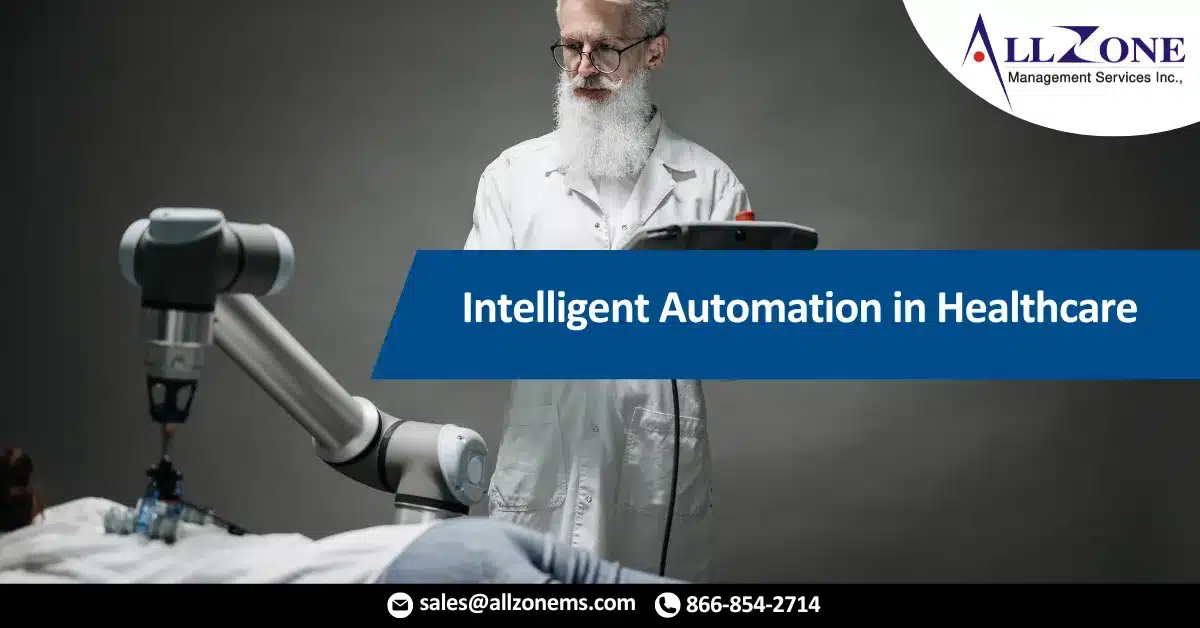Intelligent Automation (IA) is a major opportunity for healthcare providers in our country that can be an answer to the growing public health crisis. The state of healthcare in the United States is at an inflection point and the imperative to lower costs and drive efficiencies is greater now than at any other time in our history.
What’s a simple definition or explanation of intelligent automation? Intelligent Automation generally involves a software “robot” that will match the repetitive processes and actions of a human interacting within digital systems. It can deliver direct profitability back into your facility while streamlining workflows, reducing errors, and saving time and resources.
These tasks may include data manipulation, integrating or passing data to/from various applications, triggering responses or executing on a transaction. Automation is non-invasive as it is overlaid on existing systems without modifying the application’s code. A software robot never sleeps, makes zero mistakes and frees employee time to perform more important, strategic tasks
Intelligent Automation presents a unique opportunity for providers to realize gains. Across healthcare, providers remain the least likely to have deployed these tools to drive results. Beyond labor savings, these projects most commonly focus on revenue cycle opportunities and back-office processes in finance and supply chain. For example, they can include:
- Revenue Cycle Management
- Claim Submissions
- Insurance Verification
- Denials Management
- Medical Coding
- Supply Chain Processes
- Inventory Management
- Contract Management
- Administrative
- Accounts Receivable/Accounts Payable
- Customer Service
- Employee On boarding
- Payroll
Importantly, IA platforms offer an opportunity for an organization to further develop its capabilities in more advanced Artificial Intelligence (AI) arenas like machine learning, natural language processing, and other technologies that separately would not be possible otherwise.
IA tools and platforms were developed well over a decade ago by large global financial institutions and payers. Today, these platforms are growing, indicating they are here to stay and not just a trending fad. Gartner estimates that the enterprise automation market will grow an average of 35-40% a year thru 2024.
Ironically, what began with payers spread to other sectors of healthcare including suppliers and distributors, but the lowest level of penetration or automation investment remains with providers.
According to a recent study, healthcare providers had the lowest level of investment in automation across all other healthcare sectors. The 2018 study showed that healthcare providers were only 33% likely to have had significant investment in IA. Meanwhile, more mature industries like payers/insurance were double that level and as much as 63% likely to have had significant investment in IA. Many payers, and now increasingly many suppliers, have armies of software working in their environment to process claims among other administrative tasks.
This platform holds such promise for healthcare for several reasons. Because the platform mimics the tasks of human counterparts, it is leveraging existing application investments. Meaningful use requirements mandated that providers invest in electronic medical records (EMR) platforms to perform certain tasks in the hospital and clinical environment. Many of these providers have struggled to integrate the EMR with other applications. Further compounding the problem, clinical colleagues have often been asked to perform more administrative tasks in these systems adding to workforce fatigue. IA offers such an opportunity in healthcare because it leverages existing healthcare technology investments and it helps reduce administrative and clinical workforce burnout risks.
More than its appeal to healthcare specifically, IA projects are uniquely valuable in industry today. These efforts don’t require large yearlong projects with massive resources. They are affordable and within reach for any organization. Given that these tools don’t require full-stack application investments, they can be deployed in 5-6 weeks. In addition to labor savings, projects often target revenue cycle opportunities or material cost reductions to realize payback in less than 12 months.
The variety of healthcare focused projects and solutions is almost limitless. One provider focused on automating claims submissions to 3rd party payers. The bot accessed claims from the EMR system and then submitted them to a claims gateway. The project payback was achieved in nine months. In another project, a bot was able to read a patient’s insurance card and then access the corresponding payer website to confirm and verify benefits. The relevant benefits information was then confirmed in the provider’s EMR system or updated as required. These are just a few of the many projects that are being developed today by healthcare providers.
Finally, a significant benefit of intelligent automation is that it opens a field of tasks and libraries that allow providers to access new technologies. For example, computer vision tasks allow for optical character recognition where cameras on devices can be used as inputs to convert logos and text to values that a bot can process. Machine learning tasks can be applied to data from automation processes. Natural language processing and chatbot capabilities are used with many bots to provide more accurate guidance to caregivers in a variety of healthcare settings. These capabilities are more easily accessible when deployed via intelligent automation than as standalone technologies embedded in other solutions.
It’s important that providers recognize the opportunities today to use bots to lower costs in our healthcare environment. While others in healthcare like payers, suppliers and distributors have been investing in these solutions, providers now too can capture the benefits of these solutions. Experience shows that when providers start with one or two small automation projects, they typically add more after finding initial success. As more bots come online, providers will to find that this virtual workforce helps to complement the needs of its traditional clinical and administrative workforce, benefitting all parties and helping to drive savings in the healthcare industry.
For More Information: https://www.cioapplications.com/cxoinsights/intelligent-automation-in-healthcare-opportunity-for-all-nid-5200.html

